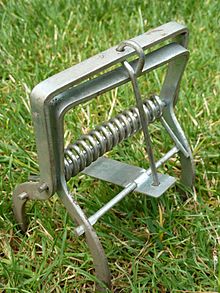- Molecatcher
-
Molecatching is the process of trapping or killing moles in places, notably farms and gardens, where they are considered a threat to crops, yards or gardens.
Contents
History of molecatching
Excavations of Ancient Roman sites have revealed countless earthenware pots that are buried into the ground. It is believed that the pots were filled with water and acted as a trap for moles; it was a simple yet deadly trap, as any mole that would fall into the pot would drown in the water.
As time wore on, traps used to catch and kill moles have become more advanced and complicated. The traps have gone from being earthenware pots to being wood, and eventually steel, traps that were designed to ensnare any mole that passed under them. A popular material for building traps is clay. Clay retains little scent of the human beings that set the trap.
Traditional molecatchers
Traditional molecatchers traveled from farm to farm in order to catch moles. The molecatcher's clients would provide food and lodgings. Also, the molecatcher would be paid for every mole caught; he would earn extra money by selling the moleskins to fur dealers. Also, until quite recently, plumbers used moleskins to “wipe”, or finish, joints in lead piping.
In more modern times (late 19th-early 20th century), British molecatchers were paid over 50p by farmers and gardeners for every mole caught. Fur dealers and plumbers would pay several pence a piece for each of the moleskins.
Since the removal of Strychnine from the UK market in 2006 (see below) there has been a revival of traditional molecatching in Britain.
Modern molecatchers
In recent times, traditional molecatching (such as using clay and steel traps) has given way to the use of poison. Although the usage of poison results in moles dying much more quickly and in greater numbers, ethical and environmental concerns have been raised over poison being an inhumane method of pest control and the possibility of other animals that interact with moles becoming poisoned as well.
Poisoning using Strychnine is no longer an approved method of control in the UK following the withdrawl of the poison from the market in 2006. Fumigation is still an approved method of control using products based on Aluminium Phosphide (Trade names 'Talunex' and 'Phostoxin') but may only be carried out by fully trained operatives.
Modern traditional mole catchers use traps, and usually charge a 'per mole' fee like their forebears. The price charged reflects the fact that there is no longer a market for moleskins.
Alternative
The mole's status as a hated pest can be resolved in gardens without recourse to molecatchers or poisons or traps. One solution to the visual problem of molehills on lawns is to carefully remove the earth (without damaging the moles' tunnels), allowing the moles to continue their existence in their galleries under the lawn. This method is not advised by mole catchers as it can lead to an uneven surface.
Both the Department for Environment, Food and Rural Affairs and Natural England do not recommend live relocation. On farms if silage is contaminated with molehill earth this can result in deadly listeria being passed to sheep and cattle. Studies in Europe have shown that widespread field infestations can reduce product yield by up 30%.[citation needed]
Sonic devices have not proven successful in moving mole problems.
External links
- A directory site listing mole catchers all over the UK
- Association of Professional Mole Catchers
- British Traditional Molecatchers Register
- Guild of British molecatchers
- 20 interesting facts about moles on the Guild of British Mole Catchers website (see column on right side)—also discusses the history of mole catching:
Categories:- Hunting by game
- Pest control
Wikimedia Foundation. 2010.

